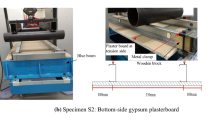Abstract
The composite panel of this study consists of two C-section steel wall studs with gypsum wallboard attached to both flanges of the stud with screws at regular intervals. It is assumed that an axial load is applied to the centroid of the gross cross section for each stud. The bracing from the wallboard connected by screws is represented by elastic springs in the analysis. The panel is subject to both flexural buckling and torsional-flexural buckling. Using the differential equation of equilibrium and an energy method, the flexural and torsional-flexural buckling loads are evaluated. Equations to determine the buckling loads are developed considering typical end-conditions. Local buckling effects and nominal buckling stress are determined according to 1986 and 1996 AISI specifications. Predictions and observed strengths from the limited experimental database were in good agreement. The predictions accurately represent the overall torsional-flexural buckling failure for the gypsum board-braced steel wall studs and its independence of stud spacing.
Similar content being viewed by others
References
American Iron and Steel Institute (1996).Specification for the Design of Cold-Formed Steel Structural Members, Washington, D.C.
American Iron and Steel Institute (1986).Specification for the Design of Cold-Formed Steel Structural Members, Washington, D.C.
Miller, T. H. (1990).Behavior of Cold-Formed Steel Wall Stud Assemblies Subject to Eccentric Axial Loads Ph.D. thesis, Cornell University, Ithaca, N.Y.
Miller, T. H., and Pekoz, T. (1994). “Behavior of Gypsum-Sheathed Cold-Formed Steel Wall Studs,”J. of Structural Engineering, ASCE, Vol. 120, No. 5, pp. 1644–1650, May.
Simaan, A. (1973).Buckling of Diaphragm-Braced Columns of Unsymmetrical Sections and Application to Wall Studs Design, Report No.353, Department of Structural Engineering, School of Civil and Environmental Engineering, Cornell University, Ithaca, N.Y.
Simaan, A., and Pekoz, T. (1976). “Diaphragm Braced Members and Design of Wall Studs,”J. of Structural Division, ASCE, Vol. 102, No. ST1, pp. 77–92, January.
Timoshenko, S. P. and Gere, J.M. (1961).Theory of Elastic Stability, 2nd edition, McGraw-Hill, New York, N.Y.
Author information
Authors and Affiliations
Corresponding author
Additional information
The manuscript for this paper was submitted for review on June 22, 2000.
Rights and permissions
About this article
Cite this article
Lee, YK., Miller, T.H. Axial strength of gypsum-sheathed cold-formed steel wall studs. KSCE J Civ Eng 4, 175–181 (2000). https://doi.org/10.1007/BF02823964
Issue Date:
DOI: https://doi.org/10.1007/BF02823964




